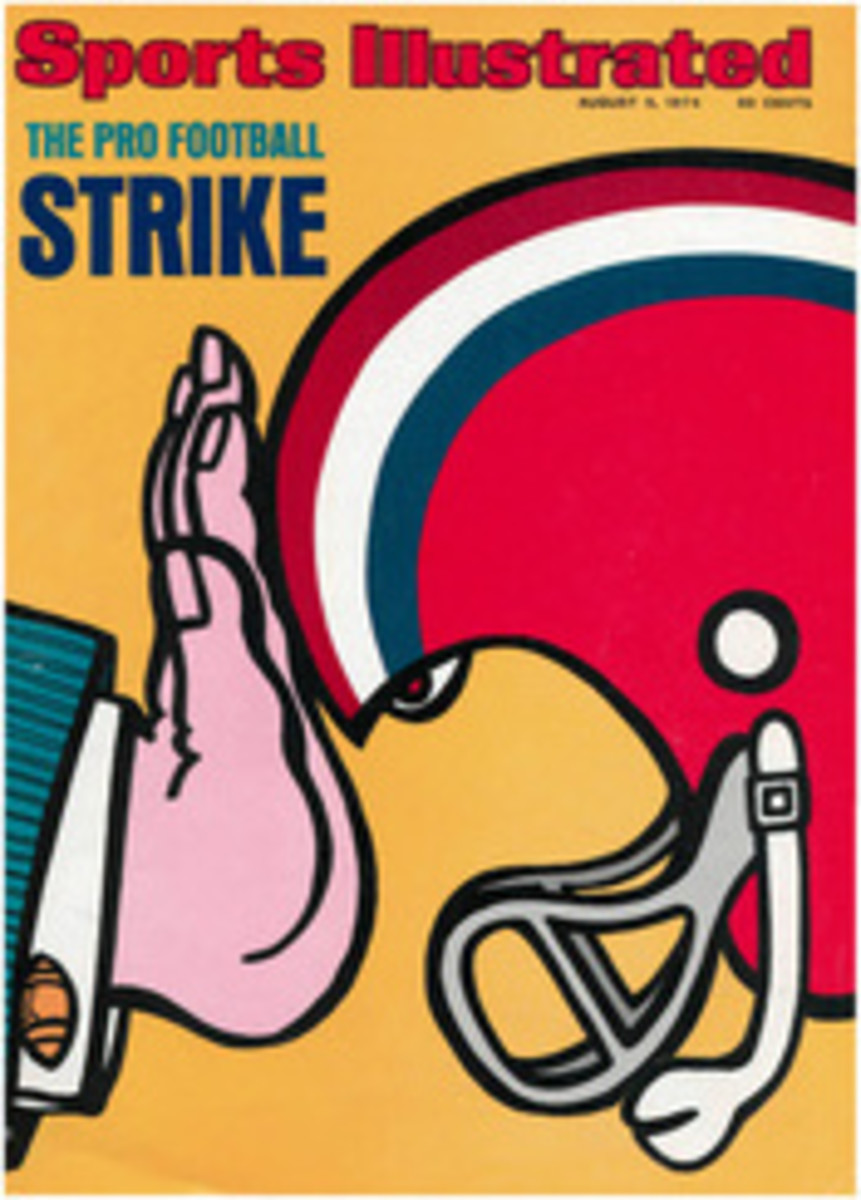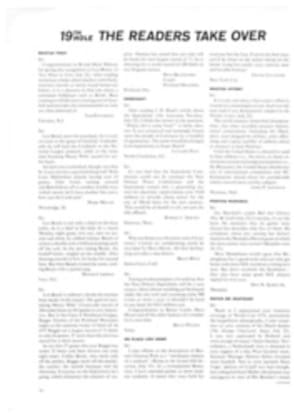
THEY KNEW A WAY TO SAN JOSE
The San Jose Earthquakes, one of four teams in the Western Division of the North American Soccer League, defeated the Vancouver Whitecaps the other night in San Jose 3-1—not a headline-making event in the world of sport. The soccer was hardly faultless, and the result settled no important issue. What did matter was that the game was played before a crowd of 17,670—an astonishing number for a U.S. soccer game—which enjoyed itself enormously and came within 400 of filling to capacity ancient, decaying Spartan Stadium, home of the San Jose State Spartans.
The Earthquakes were in second place in the NASL West and, with three games to go in the regular season, were fighting for a wild-card spot in the playoffs. But the crowd was not on hand just because of the race. San Joseans came out on this particular steaming, humid evening—as they had for most of the season—because the Quakes were their very own major league team, their first and only major league team, and San Jose had taken them to heart. But San Jose was not the only team beloved in the NASL West that night. At the very same hour up in Seattle, the Sounders were host to the division-leading Los Angeles Aztecs, and in soccer terms, their crowd was astonishing, too—14,876, the third straight Sounder home-game sellout.
The man who got major league professional soccer to San Jose is Milan Mandaric, a 35-year-old transplanted Yugoslavian. Mandaric played soccer at something less than world-class level at home; his real skills were managerial. His father ran a small machine shop in Novi Sad, 45 miles from Belgrade. As a child he helped out, and then took a degree in mechanical engineering. At 21 he opened his own machine shop, which was so successful that he was eventually invited to leave the country. He had 200 employees, and Tito's government frowned on privately owned businesses employing more than 10. Mandaric split his company into 20 companies hiring 10 each, but the subterfuge did not work for long and he had to split. In 1965, when he was 26, he went to Zurich and established a metal-working plant there. It was beginning to show a profit when he came to the U.S. for a vacation in 1969 and discovered free enterprise American-style.
"Here is free," Mandaric said the other day in Saratoga, Calif., sitting on his patio, overlooking a swimming pool and a tennis court. "No restrictions. People respect your ability. You can do what you can do."
He decided that the most promising field in California was the manufacture of electronic components, about which he knew absolutely nothing. Nevertheless he took the $40,000-odd he had from the sale of his Swiss company and in five years built the Lika Corporation—named for the district in which he was raised in Yugoslavia—to a firm worth some $15 million.
"He's a charger," says Dick Berg, who is the Quakes' general manager and a major factor in the team's early success. "He has immense charm, immense ability to make people do what he wants them to do."
Mandaric hired Berg away from the San Francisco 49ers and Berg accepted the job with one stipulation: that the soccer team be situated in San Jose and be identified with San Jose.
San Jose was (and is) a city with an inferiority complex. Located 50 miles south of San Francisco, it is too far away to be a bedroom suburb and too close to have its own identity. In years past, people who lived in San Jose seemed to find it necessary to identify themselves geographically as coming from "a little bit south of San Francisco." The success of the Quakes has already changed that. Now, natives say "San Jose" the way people who live in Green Bay might say "Green Bay."
"The reason I insisted that the club be located in San Jose was that there are too many major league clubs in San Francisco, and the people in San Francisco are blasé," says Berg. "In the San Jose area there are a million and a half people looking for something like this. I didn't want us to be the last team in San Francisco. I wanted this club to be No. 1. And it is."
Mandaric outbid two groups for the franchise, but the established owners in the league had assumed that he would situate in San Francisco or Oakland, which would be good for prestige if not for the gate.
Berg, meanwhile, was choosing a team name. "I picked Earthquakes," he says, "and a lot of people grumbled because San Jose is not far from the San Andreas Fault, and earthquakes are not that funny around here. But it's a name you remember. Then Milan called me and said, 'Dick, you got me in a lot of trouble with that name, the San Jose Earthquakes. The owners don't like it. We have to change it.' "
Berg told Mandaric that he expected the complaint. "But it grabs you," he said. "And if we win, they won't care if we're called Earthquakes or whatever."
"They don't mind the Earthquakes part," Mandaric said sadly. "They don't like San Jose."
Mandaric and Berg eventually prevailed, and from the beginning, soccer in San Jose has been a tremendous success. The Quakes' average attendance of 15,700 is tops in the league, just ahead of Seattle. The other two teams in the division are Vancouver, which draws 11,000 fans a game, and Los Angeles, which lags with 5,000. "I drew up a list of 28 ways to get people to come out to see you play," says Berg. "No. 1, they will come out if they have talked to a player and feel they know him. No. 2, if they have talked to someone in the organization. No. 3 is to give someone, personally, some kind of handout about your game. It has to be eyeball to eyeball, personal."
The night before the Vancouver game, two of the Quakes' best players—Paul Child, a 21-year-old forward from England, and Archie Roboostoff, who, despite his Russian name, is a native-born American—demonstrated soccer techniques in a shopping center modestly described by the San Jose Chamber of Commerce as the biggest in the world. They were assisted by very pretty red-clad, miniskirted girls who are members of the Shakers, the dancing squad that promotes the Quakes.
"We don't get a farthing for this," Child said, "but it is a good thing. We know the people and they know us, not at all like it was for me a year ago in Atlanta, where we played before nobody."
Small children, usually dragging mothers and fathers behind them, stopped to watch and to ask for autographs. Berg has a family plan: for $7.50, a husband and wife and two children can come to a game.
At Spartan Stadium it was obvious that large numbers had taken advantage of Berg's plan. Tom Binford, the owner of a sales and manufacturing consulting company, was there with his wife and 9-year-old son, Tommy Jr., and a neighbor's son.
"Tommy has been playing soccer for two years," Binford said. "I got interested, and some of the players came to my Rotary Club meeting. Then, where else can you take your family for $7.50 for a whole night?"
The soccer was not top flight, but it will get better. Ivan Toplak, the coach of the Quakes, returned to the club after the World Cup competition in Germany, where he was first assistant to the head coach of the Yugoslav national team. He had also been head coach of the Yugoslav 23-and-under team. Emigrating to the U.S. was the result of long and painful deliberation.
"I had gone as far as I could go there," Toplak said last week. "I love my country, but here is where I want my son to be educated. And here is where I can teach soccer. It is much needed."
He marked off the length of a size 12 shoe on the top of a table. "In Yugoslavia a boy come to us with feet like this, we tell him, 'No, you do something else.' Little feet, good player, that is the rule. But now we get players 1.98 meters tall—I do not know that in feet and inches [about 6'6"]—we find with the big feet they play as well, sometimes better. Do not play the same, longer strides, different way to control the ball, but in some ways better. In five, eight, 10 years—I do not know how long, but sometimes, the United States will be in the World Cup and maybe will win. All they need—all we need—is coaching, for small boys on up."
Toplak, then, sees a very bright future for soccer in the U.S. It is already a quick and warming success in places like San Jose. The NASL is negotiating a TV contract for the playoffs with CBS that will pump in new money. The league will also work with the United States Soccer Federation to produce a U.S. team for 1978 World Cup competition.
Last week, though, in San Jose, in the jammed, small stadium, it must have been very much like Green Bay in 1922, when the National Football League was starting. The atmosphere was friendly, exciting, and there was rapport between players and fans. The players were not making much money, and the fans were not spending much. But everyone was having fun.
PHOTO
With 17,670 San Joseans on hand, Vancouver Forward Brian Budd heads one toward goal.
PHOTO
Mandaric and Coach Toplak leave the field.

